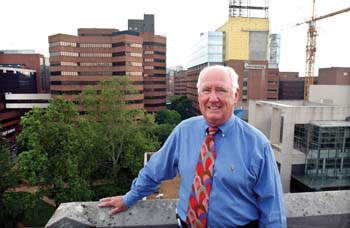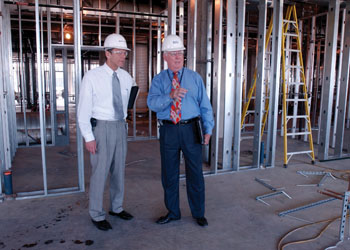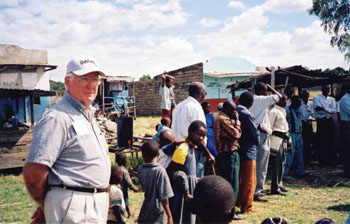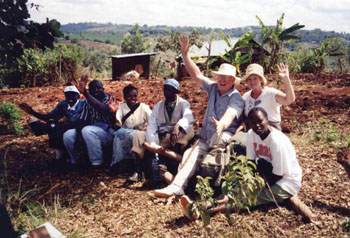
Fred DeWeese, vice president of Facilities Planning and Development, looks out over the Vanderbilt University Medical Center campus that he helps shape.
photo by Dana Johnson
Building solutions: Creativity, problem-solving skills serve DeWeese well

Fred DeWeese, center, Jeff Kaplan, right, and a contracting supervisor examine the progress of the construction project taking shape behind Langford Auditorium.
photo by Dana Johnson

One of DeWeese’s primary functions is to help Medical Center officials, such as Jeff Kaplan, associate vice chancellor for Health Affairs, visualize how space can be built and utilized.
photo by Dana Johnson

Mission work is a passion of DeWeese’s. He and his wife, Kathleen, are planning to take their third trip to Kenya later this year.

DeWeese and his wife, Kathleen, share the joy with villagers in Kenya while on a recent mission trip.
VUMC Reporter Profile
As a young boy, Fred DeWeese received a rather unusual Christmas present — a 1-cubic-foot wooden box and a 5-pound bag of nails. Although it may not have been on his wish list, DeWeese wasn't surprised; after all, his father and grandfather were both carpenters.
“I just covered that box with nails — practicing,” DeWeese said. “But I knew I didn't want to be a carpenter early on. I really couldn't handle a hammer.”
DeWeese's instrument of choice would be a pencil instead.
“I liked to draw. In fact I nearly flunked a couple of health courses in seventh grade when the teacher caught me drawing,” DeWeese said. “I started drawing my city map, a map of the little town I lived in of about 2,000 people in northeast Oklahoma. I could draw every street in that town.”
Little did DeWeese know he'd go from sketching the town of Barnsdall, Okla. on a notebook to sketching plans for multi-million dollar research buildings.
DeWeese, now Vanderbilt University Medical Center's vice president of Facilities Planning and Development, said that after more than 40 years in the business, he's pretty much put down his pencil.
“Well, some people say I still draw, but I don't,” he said. “Just on the back of envelopes, sketchy ideas. Actually, the design for the top of Light Hall and Langford for MRB IV happened on a napkin at lunch one day with the architects out in New York.”
Whether he draws or not, DeWeese's creativity and problem-solving ability are at the heart of the Medical Center's building success over the past six years.
“Fred is a tremendous asset to Vanderbilt,” said Harry R. Jacobson, M.D., vice chancellor for Health Affairs. “He has the ability to find solutions when there seem to be none in sight, and that has made him a driving force behind the continuous growth of the Medical Center. Indeed, our plans for MRB IV, the Institute of Imaging Sciences and the new 'dry lab' research building to be placed over The Vanderbilt Clinic would not be if it were not for Fred's creativity and vision.”
Steven G. Gabbe, M.D., dean of the School of Medicine, agrees.
“Fred is an amazingly talented architect; he's so creative. He has come up with ways to help us meet our space demands that none of us mere physicians could ever have dreamed of. Without his creativity, many of the facilities we enjoy would never have been built.”
Since joining Vanderbilt in 1999, DeWeese has been intimately involved in numerous building projects, from small renovations to the opening of a freestanding children's hospital. He's a part of the process from when the idea for new space is first mentioned until the last box is moved in. And DeWeese said he enjoys every bit of it.
“Construction is exciting, and the design side is even more exciting because you can literally see what the project is going to look like before it's even built,” DeWeese said. “You have that rush, if you will, knowing what it's going to be. It's very exciting to be a part of that.”
Early Renderings
DeWeese's passion for construction was developed as a child, watching his father build homes.
“The company he was working for back in the late 40s and early 50s was developing refineries all over Texas and Oklahoma, and they would build homes for the people who were going to work at the gasoline plants,” DeWeese said. “We would live near those places, either in trailers or in one of the half-built homes, and being there I got to see all of the construction as a small child. Just the allure of watching things being built, from taking a piece of ground and laying out 20 to 30 houses on it and watching them go up simultaneously, was really exciting.
“It was really fun watching my father do that, and just the smell of construction got in my blood.”
DeWeese took his love of construction and drawing with him into the architecture program at the University of Oklahoma. He transitioned from a high school class of 22 to a first-year architecture class of 80.
“Barnsdall was this old, little oil town,” he said. “It's only claim to fame was that it was the only town in the world that had an operating oil well in the middle of Main Street. It was a different environment back then. I bet that less than one-third of my high school class went to college. But my parents were very supportive and thrilled that I wanted to be an architect.”
DeWeese was the first in his family to graduate from college, but it was no easy feat.
“Only 13 members of our entering class graduated. There were a lot of drop-outs,” DeWeese said. “I struggled at first, especially with math. But then one day my advisor, this professor at the school, called me in and told me, 'You'll never graduate. You ought to quit right now.' And that was the shock I needed. Every semester after that I made the dean's honor roll.”
That same determination and drive also helped him through the other difficulties faced during that time in his life.
“My dad died my sophomore year, when I was 20 and he was 50,” DeWeese said. “Our family didn't have the resources to send me to school, so the company that he had worked for offered me a job at the gasoline plant that was about 15 miles away from school.”
For four years DeWeese spent 20 hours a week loading tank cars and trying to fix big engines he knew nothing about. He also developed an appetite for ties that would stay with him throughout his career.
“A co-worker brought me a box of polka dot ties, with dots ranging from two-and-a-half inches in diameter to pin dots; I guess that started it,” DeWeese said. He's been collecting ever since, and his colleagues say he has the best ties on campus.
After making his way through college, and with a new collection of ties, DeWeese moved on to an internship.
“I made more money doing that ugly gasoline plant job than the day I got out of school and got my first job in an architect's office. I thought, 'did I make the right decision?'” DeWeese said.
Constructing a successful career
DeWeese soon realized he was on the right track, and went from his internship to working for Southwestern Bell Telephone Co. Soon he was managing 12 architects on staff and later managing the construction of a $120 million office building for the company's corporate headquarters in St. Louis and a $140 million data center.
“The process of building these buildings is very similar to the process here at Vanderbilt,” DeWeese said. “In fact, some of the critical things for their huge data center are some of the same critical things for operating rooms and labs — emergency power, emergency air-conditioning, etc. That training was very helpful for me.”
DeWeese also learned the accounting and finance processes.
“Nothing is free,” DeWeese said. “You always have to figure out how your project is going to be paid for, and I felt that I was able to get a good working knowledge of finances.”
In 1991, after 25 years of service to the company, Southwestern Bell offered a somewhat forced incentive retirement. DeWeese took his check, but he certainly wasn't ready to quit working.
“The next day after I retired, I went to work for Washington University in St. Louis,” DeWeese said. There he built a facilities staff from the ground up and helped the academic center construct $400 million worth of research buildings. DeWeese also got the opportunity to build a new relationship that he said is invaluable.
Love in the fast lane
Kathleen DeWeese said she was on her way to work as normal that day, and by normal, she means running late and speeding all the way. She zoomed past a van that was moving too slow and exited off the highway to get to her parking structure.
“I parked in the garage and was rushing to my job at Washington University,” Kathleen said. “That was when I heard a voice say 'So that was you who cut me off on Highway 40?' I said, 'I did?' and Fred responded, 'Yes, I thought you were going to run me over.' I told him, 'I guess you were just going too slow,' and went on in to work.”
It wasn't long before DeWeese and Kathleen started dating.
“I just thought he was so handsome and such a gentleman,” Kathleen said. “And all my friends were asking, 'Does he have a brother?' But he's just one of a kind — with such a beautiful heart.”
DeWeese was equally taken with Kathleen. “We have a great time together. Kathleen is beautiful and exciting,” he said. “She's truly my soul mate. She makes my every day.”
The couple soon married and blended their families. Together they have 11 grandchildren, ranging in age from newborn to 22.
“She's the middle child of 13 and I'm an only child,” DeWeese said. “Not to mention she's from Minnesota. It's made for a lot of fun.”
Along with spending time with their grandchildren, the DeWeeses enjoy gardening, being active in their church, and dancing when they get a chance.
“Fred's a wonderful dancer,” Kathleen said. “We go out dancing when we can, but sometimes we just dance here in the house.”
“And half the time she leads,” DeWeese said.
Moving a little further south
However, DeWeese was leading when, after more than six years at Washington University, Vanderbilt came calling
“I called up my wife and said, 'How would you like to go to Nashville?'” DeWeese said. “She said, 'Why Nashville?' I told her she'd love it and we came down for a visit. She fell in love with the city, and so did I.”
“I thought I was in the South in St. Louis,” Kathleen said. “But I just love it here. The people are so wonderful.”
DeWeese was familiar with Vanderbilt; his son graduated from the School of Medicine.
“I knew it was a great opportunity when I received that call, and visiting just confirmed that,” DeWeese said. “The people I met were warm and accommodating, and I was thrilled to join this team.”
It didn't take long for DeWeese to plunge into his work. Already, the Children's Hospital project had started, as well as MRB III, and his first year here he helped build the heliport.
“That project had all kinds of challenges,” he said, “the biggest being building on top of a functioning hospital. But we have great people on our staff and great people that we work with. They come here and the chemistry is great; we solve problems just through dialogue and the discussions that are going on. And it's wonderful to be a part of that — it's positive.”
As the vice president of Facilities Planning and Development, DeWeese spends a lot of his time meeting with people throughout the Medical Center, finding out what their building and space needs are and then developing solutions to meet those needs.
“Working with Fred is an absolute delight,” said Corey Slovis, M.D., professor and chair for the Department of Emergency Medicine. “He is one of the most customer focused people I have ever had the privilege of working with. He listens actively, investigates and obtains objective data, then comes back with fair and insightful comments, answers or solutions. He doesn't say why we can't do something; he looks for the ways to do the right things.”
DeWeese said working in academic medicine has been rewarding, and although he's always enjoyed problem-solving, it has driven him to work even harder.
“If we can do something in the way we build facilities that enhances research or patient care or that enables it to happen more readily, then we've been very successful in what we've done,” DeWeese said. “Just to be a part of that is incredible — to be able to provide facilities that these bright people can work in. Just build them and get out of their way and let them work, because they could find something that could help you or your children or my grandchildren or generations to come.”
During the past six years, DeWeese has helped by leading up numerous projects, the most recent being Medical Center East South Tower, the new Emergency Department, and MRB IV, which will continue through next year.
“Fred is so valuable to us as an organization because of his wealth of knowledge and his personal character,” said C. Wright Pinson, M.D., associate vice chancellor for Clinical Affairs. “He is a 'can do' guy who is always willing to help, from big projects to small questions. And personally, he is fun to be around.”
The challenge, DeWeese said, is keeping up with the growth that's taking place.
“Vanderbilt has a lot of new leadership, and it's just a catalyst for change,” he said. “It's going to change, and it should. But it's difficult to get ahead of the momentum that's created. To me, that's the biggest challenge: how do you get ahead to meet those needs? It's a good challenge to have.”
Even more, DeWeese said, it's making changes that will be meaningful down the road, ones that will be beneficial well into the future.
A giving heart
After moving to Nashville in 1999, DeWeese soon found another passion in his life — missionary work. DeWeese and his wife became active in the Forest Hills Baptist Church, which has a strong mission emphasis. They heard stories from a friend who traveled to Kenya numerous times.
“She told us the stories and was so passionate about the people there, it was just contagious,” DeWeese said. While Kathleen was first to decide to make the journey, DeWeese soon came on board, and the two made their initial trek to Africa in 2003. They are planning their third trip for this October.
“It's a passion I really can't explain,” DeWeese said. “We just walk around and tell people about the good news. It's hard work, but really rewarding. You just go from little hut to hut, and they'll let you in, and they're just gracious. They'll give you the best seat in the house, and you sit down and talk.”
Along with his work in Kenya, DeWeese has been an advocate for the American Heart Association here at Vanderbilt. Every year his office sends letters to those they work with seeking support for the Heart Walk.
“The response has been overwhelming,” DeWeese said. “Traditionally, people in construction always give small Christmas gifts to people they work with. We ask that instead of giving us something, they give to the walk because it's much more needed.”
DeWeese said the companies have responded well and have given generously. The American Heart Association is a charity close to his own heart, he said.
“I haven't told many people this, but my dad died of heart disease,” he said. “I'm just happy our group has been able to get involved and help make a difference.”
“Fred has a great, huge, good heart,” said Cyril Stewart, director of VUMC Facilities Planning, who has worked with DeWeese since he arrived at Vanderbilt. “I know his Kenya trips and the walk mean a lot to him.”
Choosing to have a good day
DeWeese's huge heart has also made him a joy to work with, Stewart said.
“All the staff loves Fred, and he really cares about us. We wish he could stick around forever,” Stewart said. “He's always thinking of creative ways in planning and solving problems, and firmly believes in leaving something better than you found it. He laughs easily and doesn't let us take things too seriously.”
Keeping a positive attitude is something DeWeese firmly believes in.
“I think we have a couple of choices in life — we can choose to have a good day, and we can choose to have a bad day,” he said. “I'm thankful when I wake up in the morning that I have another day to live and to work, and I'm going to make the best of it when I get here. Nothing comes from getting upset and flying off the handle about things. Everything has a solution in its time.”
Although he keeps a positive attitude and outlook on life, DeWeese said he does struggle with the question “am I doing enough?”
“I often wonder if what we're doing is good enough,” he said. “I just hope that I'm able to meet everyone's expectations.”
His colleagues said he does that and more.
“Fred is truly the 'total package.' He is incredibly knowledgeable regarding the Medical Center, possesses superlative expertise in his field, is able to think outside of the box and is a total gentleman in the best sense of the word,” said Jeff Kaplan, associate vice chancellor for Health Affairs. “In short, it is a pleasure and honor to work with him.”
While construction may be in his blood, it's DeWeese's heart that has shaped his life. It's his love and admiration for those around him that will keep him building for Vanderbilt's future.
“I've been working since I was 14, which is a long time. But I keep coming back because of the people,” DeWeese said. “There are some exciting, bright people here, from the architects and engineers who design the buildings to those who build them. And the researchers and doctors — you work with these people, and man, they are bright. It's good to rub shoulders with those kind of people, and I just want to help them all I can.”
Although DeWeese will eventually put down his pencil for good and leave building great buildings behind, his passion will remain at Vanderbilt, chiseled in the mortar and brick that will continue making a difference in people's lives.













